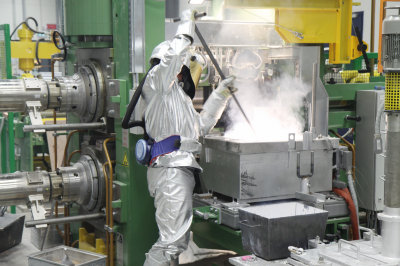Ultralight vehicles: New cooperative venture strengthens magnesium research in Geesthacht
In the framework of the World Premier Materials (WPM) development programme, the South Korean government has provided more than 100 million dollars to fund research and development in the field of magnesium technology. The Magnesium-Innovations Center (MagIC) in Geesthacht will be an important scientific project partner. Intensive research into the magnesium technologies of the future will be conducted on this unique research platform under the leadership of Prof. Dr. Karl Ulrich Kainer.

The researchers are studying magnesium sheet materials and casting technologies, to make them applicable for use in vehicle. Photo: HZG/ Christian Schmid
The South Korean programme for the development of ultralight vehicles has met with great interest in Germany. More than 80 German and South Korean participants came together in Irsee (Bavaria) at the beginning of February 2012 in order to discuss the first steps to be taken. Materials scientists from the Helmholtz Center Geesthacht were joined by representatives from global corporations such as VW, BMW, POSCO, Thyssen and also from the TU Munich and Bergakademie Freiberg (Mining Science University). The participants exchanged ideas on casting and rolling technologies, magnesium sheets and wrought magnesium materials. Specific initial bilateral collaborations between industry and research were agreed upon.
The Geesthacht magnesium research scientist, Dr. Dietmar Letzig, stated: “The meeting was highly successful and resulted in many useful contacts. We know that there is a great demand for light materials in the automotive sector. Vehicle manufacturers are the most important market for magnesium sheet metal. However, a number of real challenges remain, such as, for example, corrosion resistance and security of supplies”. The engineers and scientists of the major automobile and aircraft manufacturers are working intensively on the construction of lighter cars and aircraft, as each kilo reduced means a reduction in fuel consumption and thus also in CO2 emissions.
The weight of magnesium is only a quarter of that of steel, and it is 30 percent lighter than aluminium. Magnesium is, therefore, already being used successfully in many areas of automobile construction. These parts are generally produced with casting processes, such as in undercarriages for instance. For large surface body parts such as doors, flaps, or roofs, in which a lightweight construction material could save even more weight, the use of rolled magnesium sheets is advantageous. Materials research scientists in Geesthacht are carrying out investigations into such rolled magnesium sheets with regard to applications in vehicle construction.
An ultramodern casting and rolling plant is available to scientists on the premises of the research centre for this purpose. Research is also being carried out into special anti-corrosion coatings which protect the surfaces of the magnesium components against damage in a wide range of applications.
More about World Premier Materials (WPM)
In the framework of a project to secure ten key materials for industry, the so-called World Premier Material (WPM) Development Programme (2010 – 2018), the Korean government has selected 220 enterprises and research institutes, including major companies such as POSCO Ltd. or Samsung, and divided them into ten working groups. One of these is the “Magnesium Research and Development Project for Ultralight Vehicles” in which the Helmholtz Centre Geesthacht is an acting partner. Other projects are focussing on, for example, energy efficient multifunctional nanocomposites or sapphire single crystal materials for LEDs. The objective of the WPM development programme is to promote the supply of industrial materials for global markets which are anticipated to be worth billions in the future. The Korean government intends to invest a total of one billion US dollars in the ten working groups and thus gain a share of more than 30% of the global market in major new industrial sectors for these materials.
About MagIC – Magnesium Innovations Center
The MagIC centre carries out research on magnesium materials for diverse applications (e.g. traffic engineering and medical technology). A particular focus lies in the development of alloys and the optimization of existing and new manufacturing processes. Fundamental research based on scientific knowledge and practice-oriented investigations are necessary in order to maintain an optimal spectrum of material properties when using magnesium in applications. MagIC offers proven expertise and the appropriate facilities for this purpose. At present the centre is divided into four departments for the research and advancement of magnesium materials.
Contact

Max-Planck-Straße 1
21502 Geesthacht
